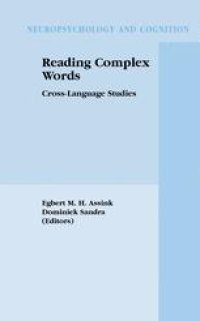
Ebook: Reading Complex Words: Cross-Language Studies
- Tags: Child and School Psychology
- Series: Neuropsychology and Cognition 22
- Year: 2003
- Publisher: Springer US
- Edition: 1
- Language: English
- pdf
In a series of fourteen chapters this book brings together current research findings on the involvement of word-internal structure for the purpose of word reading (especially morphological structure). Contributors include many leading experts in this research domain. The central theme of reading complex words is approached from several angles, such that the chapters span a wide variety of topics where this issue is important. The experiments reported in the book involve:
- different populations : children, expert readers, illiterates;
- different languages: Chinese, Dutch, English, French, Hebrew, Italian, Turkish, Serbian;
- different processing levels where morphology may play a role: sublexical, supralexical;
- different variables which may determine morphological effects: morphological type, semantic transparency, branching relations among morphemes.
In a series of fourteen chapters this book brings together current research findings on the involvement of word-internal structure for the purpose of word reading (especially morphological structure). Contributors include many leading experts in this research domain. The central theme of reading complex words is approached from several angles, such that the chapters span a wide variety of topics where this issue is important. The experiments reported in the book involve:
- different populations : children, expert readers, illiterates;
- different languages: Chinese, Dutch, English, French, Hebrew, Italian, Turkish, Serbian;
- different processing levels where morphology may play a role: sublexical, supralexical;
- different variables which may determine morphological effects: morphological type, semantic transparency, branching relations among morphemes.
In a series of fourteen chapters this book brings together current research findings on the involvement of word-internal structure for the purpose of word reading (especially morphological structure). Contributors include many leading experts in this research domain. The central theme of reading complex words is approached from several angles, such that the chapters span a wide variety of topics where this issue is important. The experiments reported in the book involve:
- different populations : children, expert readers, illiterates;
- different languages: Chinese, Dutch, English, French, Hebrew, Italian, Turkish, Serbian;
- different processing levels where morphology may play a role: sublexical, supralexical;
- different variables which may determine morphological effects: morphological type, semantic transparency, branching relations among morphemes.
Content:
Front Matter....Pages i-xxii
Linking Morphological Knowledge to English Decoding Ability: Large Effects of Little Suffixes....Pages 1-25
The Effects of Morphological Structure on Children’s Reading of Derived Words in English....Pages 27-52
Morphological and Phonological Analysis by Beginning Readers: Evidence from Serbian and Turkish....Pages 53-80
Recognizing Morphologically Complex Words in Turkish....Pages 81-92
Word Decomposition in Hebrew as a Semitic Language....Pages 93-111
Morphological Representation as a Correlation Between form and Meaning....Pages 113-137
A Supralexical Model for French Derivational Morphology....Pages 139-157
Parsing and Semantic Opacity....Pages 159-189
Effects of Sublexical Frequency and Meaning in Prefixed Words....Pages 191-219
Morphological Parsing and Morphological Structure....Pages 221-239
Morpheme-Based Lexical Reading: Evidence from Pseudoword Naming....Pages 241-264
Word Reading Processes in Adult Learners....Pages 265-293
Reading aloud polysyllabic words....Pages 295-314
Homophonous Regular Verb Forms With a Morphographic Spelling: Spelling Errors as a Window on the Mental Lexicon and Working Memory....Pages 315-330
Back Matter....Pages 331-339
In a series of fourteen chapters this book brings together current research findings on the involvement of word-internal structure for the purpose of word reading (especially morphological structure). Contributors include many leading experts in this research domain. The central theme of reading complex words is approached from several angles, such that the chapters span a wide variety of topics where this issue is important. The experiments reported in the book involve:
- different populations : children, expert readers, illiterates;
- different languages: Chinese, Dutch, English, French, Hebrew, Italian, Turkish, Serbian;
- different processing levels where morphology may play a role: sublexical, supralexical;
- different variables which may determine morphological effects: morphological type, semantic transparency, branching relations among morphemes.
Content:
Front Matter....Pages i-xxii
Linking Morphological Knowledge to English Decoding Ability: Large Effects of Little Suffixes....Pages 1-25
The Effects of Morphological Structure on Children’s Reading of Derived Words in English....Pages 27-52
Morphological and Phonological Analysis by Beginning Readers: Evidence from Serbian and Turkish....Pages 53-80
Recognizing Morphologically Complex Words in Turkish....Pages 81-92
Word Decomposition in Hebrew as a Semitic Language....Pages 93-111
Morphological Representation as a Correlation Between form and Meaning....Pages 113-137
A Supralexical Model for French Derivational Morphology....Pages 139-157
Parsing and Semantic Opacity....Pages 159-189
Effects of Sublexical Frequency and Meaning in Prefixed Words....Pages 191-219
Morphological Parsing and Morphological Structure....Pages 221-239
Morpheme-Based Lexical Reading: Evidence from Pseudoword Naming....Pages 241-264
Word Reading Processes in Adult Learners....Pages 265-293
Reading aloud polysyllabic words....Pages 295-314
Homophonous Regular Verb Forms With a Morphographic Spelling: Spelling Errors as a Window on the Mental Lexicon and Working Memory....Pages 315-330
Back Matter....Pages 331-339
....